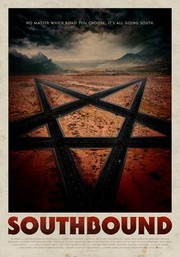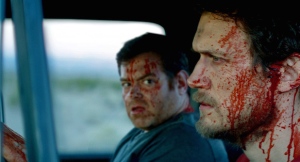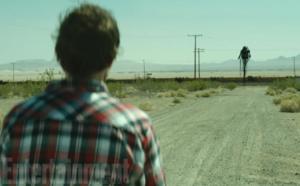Anthology films are notoriously difficult. Balancing the tone, theme, characters, and transitions can overwhelm any director, let alone four at once. When done well, though, these works are brilliantly entertaining – especially in horror. We’re lucky to have another classic in 2016. Take a ride to Hell in this year’s SOUTHBOUND.

Fresh from Toronto’s Midnight Madness section and helmed by four different directors (most veterans from 2012’s VHS), this collection of stories is all set on a mysterious road deep in the Southwest. Each of the tales revolves around this strange netherworld, and their characters all find themselves trapped there – two men on the run from wraiths, a rock band who ask for help from the wrong family, a man who has to save a woman’s life in an abandoned hospital, a crazed man searching for his lost sister. These unwitting souls confront all manner of demons, monsters and madness, just off the map.

The world of this film is astoundingly creepy and fun. It’s a deformed lovechild of Rod Serling, John Carpenter, and perhaps a dash of Flannery O’Connor – brewed in a pot of metaphysical, weird-fiction terror. “Carnival of Souls” plays on several screens throughout the stories, which gives a hint of the rules in this world – there are none. It’s unapologetically weird, and it oozes uncomfortable dread, something most horror films can’t claim. The filmmakers know how to make the viewer feel just a little bit off. So you’re scared before the mayhem even begins.

It helps, too, that each of the stories features a character who we care about (at least, I did). The writers create authentic humans with flaws and quirks, and they develop them with rapid skill. Cliches are also hard to find. That is part of the weirdness – whatever a ‘normal’ film would do, this one blatantly swerves around, or does with such bravado that it’s shocking anyway. Horror cinema rarely sees such a unique, insane universe.

I am not surprised to find out that the folks at Dark Sky Films, who brought us modern classics like “The House of the Devil” and “We Are Still Here,” are involved in this release. Larry Fessenden himself voices a sinister radio host who introduces each segment a la Mr. Serling. Like many of their offerings, this one feels retro, but it’s also rooted in our modern world, cleverly using cell phones (that actually work) and avoiding gender stereotypes. The characters are contemporary, but the nightmare is an amalgamation of 70s strangeness, 50s music and 40s wardrobe. It fits into the Dark Sky canon beautifully – and we can only hope that company will continue to make such brilliant genre pieces.
Though it is a limited release, if you can’t find it in a theater, get to it through the Internet – it’s a must-see for fans of classic horror from any decade. It’s bizarre, funny, ultra-bloody, and legitimately frightening. Turn on the ignition and drive down this dark road.








